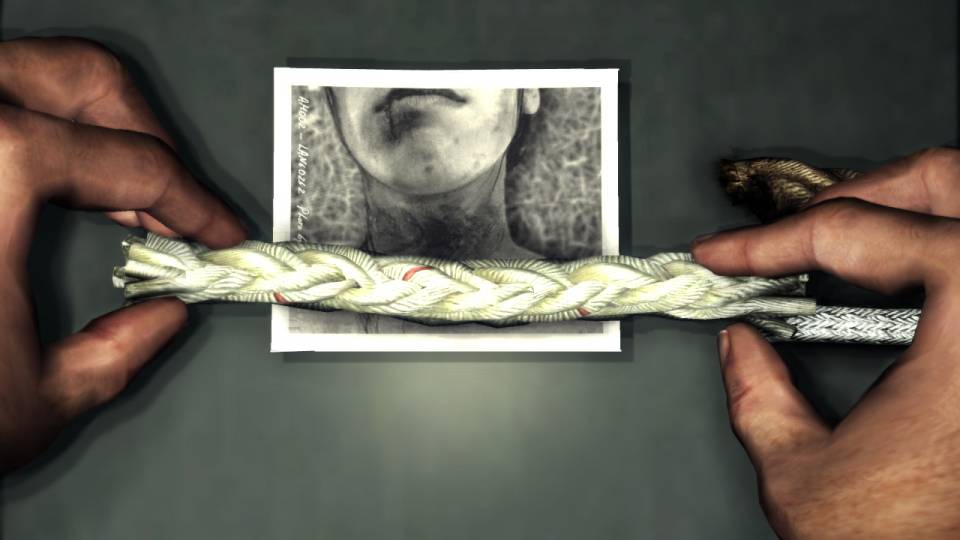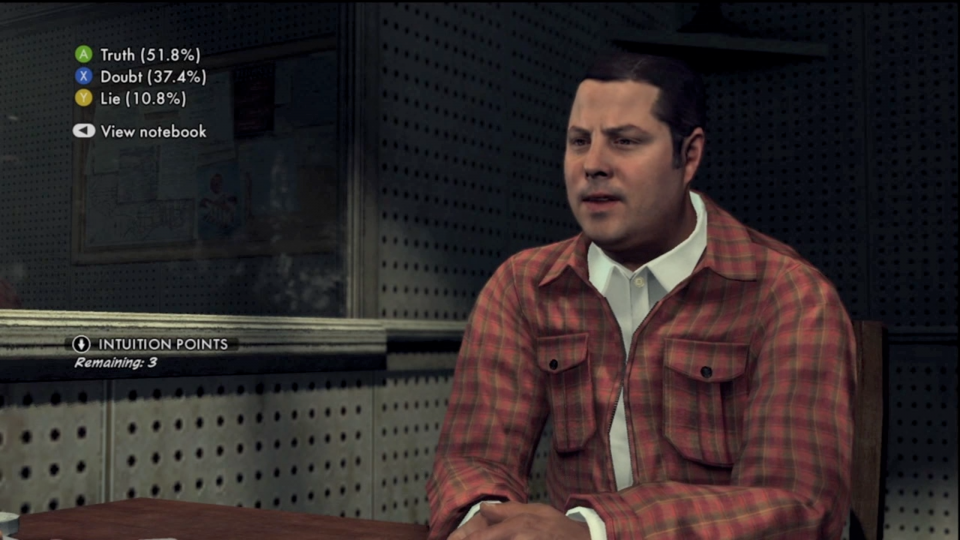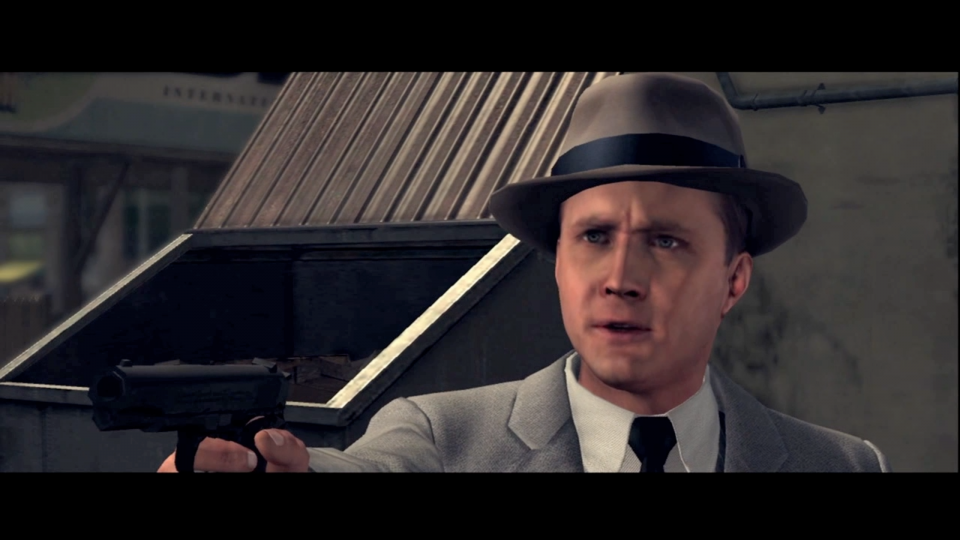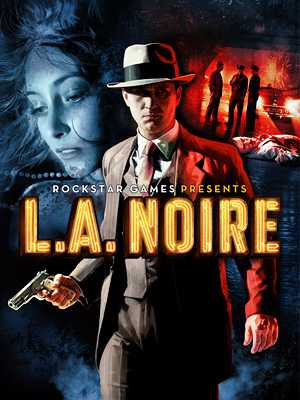Eat your heart out, Dick Tracy
L.A. Noire’s teaser trailers would have you believe it is Grand Theft Auto: 1947, and for those who buy this game expecting an open world full of hookers, dick jokes, and gratuitous nudity, there will be disappointment. Despite being published by Rockstar and featuring many of the same sandbox trappings that made them famous, tonally, this is about as far from the GTA series as possible. Team Bondi has created a rich, intriguing adventure game that deals with vice, murder, and lust in a mature way. Sadly, some poor writing and a melodramatic ending hurt the story, but it is still the strongest interactive narrative of recent history, and represents film noir deftly.
Perhaps the best (and worst, but I’ll elaborate later) qualities of L.A. Noire’s story are contained in protagonist Cole Phelps. The year is 1947, full of jazz, post-war optimism, and detective slang, and Phelps is ready to continue serving his country after a tour of duty in Okinawa. He is concerned only with bringing true justice to the seedy dealings of Los Angeles, and the LAPD is his oyster. His straight man attitude is a fresh perspective compared to the moral bankruptcy of Niko Bellic and Johnny Klebitz, and it is nice to see a Rockstar production leave the comfort zone.
But Cole is still human, and it is interesting to see how his idealism dissolves. The police captains love him and give him more than enough praise for good casework, but even they are ripe with corruption, preferring good press to real convictions. Flashbacks from Okinawa also reveal some sore wartime horrors, and Phelps slowly descends into the chaos of Los Angeles despite his diligence as a detective.
Phelps, and by extension the player, is promoted to several different departments of the LAPD throughout the story, and a formula for how each case pans out is established early on. Each new case begins with Phelps and partner rolling up to the crime scene to find evidence. This is where the game feels most like an evolution of a point-and-click adventure game. As you survey the scene, you’ll get little cues (a piano note and a slight controller vibration) that let you know when to press A to check out some evidence. Since this is 1947 forensics, Phelps can poke and prod every bloody pipe, lipstick stained cigarette, and dead body without fear of tampering with DNA or fingerprints. Good old fashioned detective work and coroner’s reports are needed to get to the bottom of gruesome murders. Phelps also has a notebook to organize clues, important locations, and suspect sketches, which only adds to the noir context.

After you’ve completely exhausted all possible clues at the crime scene—which is again signaled by a musical cue—you’ll have to question witnesses and suspects. This is the core of L.A. Noire and the facial technology that powers it is by far the most amazing feature of the game. Voice actors were actually filmed by dozens of cameras to create flawless lip-synching and performances that easily break out of the uncanny valley. I don’t want to get too hyperbolic, but this is one of the most realistic and cinematic game mechanics in the history of games. Actually seeing a witness tense up as they tell a lie, eyes shifting and lips pursing, is truly amazing and perfectly complements the hands on approach to both the evidence and interrogation. This is technology that actually makes other games look worse by comparison.
At its simplest, the interrogation boils down to asking questions and rebuttals to those questions. As you ask questions, which stem from the dirt you dig up, the questionee’s answers then prompt three response options: Truth (accept the statement as such), Doubt (you believe they’re lying, but have no proof), or Lie (you know they’re lying and have evidence to back it up).

While Truth is pretty straightforward, Doubt is the most ambiguous option, and easily the most dangerous. What is interesting is that it rides almost entirely on gut instinct. Again, this is something only made possible by the facial animation quality. And I’ll be damned if I didn’t feel like an actual detective when I chose the Doubt option.
The Lie option requires you to select the corresponding piece of evidence from your handy-dandy investigator’s notebook to back up your accusation. If you’re right, you’ll open new lines of investigation or even get a confession. But the wrong choice (accompanied by yet another musical cue) will often make suspects and witnesses shut down and make the investigation harder. Thankfully you can back out of a Lie accusation if you don’t think you have the necessary evidence.
L.A. Noire shines during the interrogations, especially when you’re certain of a suspect’s involvement and you get all answers correct. But there is frustration to be had when several cases grow convoluted and dump numerous names, red herrings, and strange circumstances at you all at once. Not only does it make choosing the correct retort nearly impossible (your heart will sink when you choose the wrong option and get the “you messed up” piano cue), but it also makes the story feel disjointed and rushed in spots.
Along with the crime scenes and interrogations there are some chase sequences, gunfights, and fist fights. These are all made fun by some much-needed automation in character movement. There is no jump button—simply hold the right trigger and Phelps will jump on his own—and sometimes the game will steer Phelps in the right direction during a chase. This sounds kind of crazy, but it works nicely to the keep the action flowing. And while the on foot chases are pretty exciting when the jazz starts blaring, most of the action is merely okay, and not nearly as interesting as the detective elements.

Each case, which usually last anywhere from ½ an hour to 2 hours, pans out with the three mechanics—the crime scenes, interrogations, and action sequences—nearly identically. After a while you sort of know what to expect from each case, which puts an unfair burden on the story to keep things interesting.
Fortunately, the script and cinematic nature of the game do achieve a stunning narrative. Moral gray areas plague all the dealings in L.A. including the LAPD, and most of the happy post-war optimism is covering festering greed and addiction. But there are still some instances of bad writing and performance. As I mentioned, most issues in the story stem from Phelps’s character. Phelps will sometimes grow far too aggressive with a witness, from suddenly shouting how he will “break your f--king jaw” for not cooperating to calling an elderly woman a “hag”. The writers obviously sought to make the story much more dramatic than it needed to be. Perhaps the most egregious fault comes from the ending that is rushed—despite the game being over 20 hours long—and severely overdramatic.
Despite the few tonal gaffes, L.A. Noire is an incredibly important game. Facial animation and skillful execution of film noir have never been done like this before. If you’re a gamer who wants to promote good interactive storytelling, or someone who wants to see noir represented in video games, then pick this one up now.
